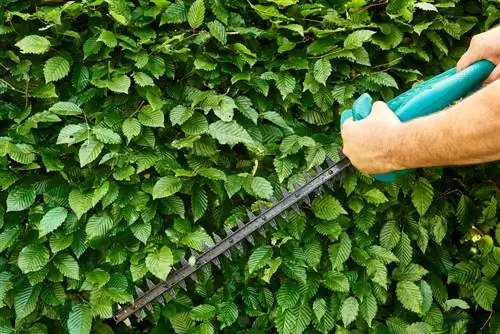- Author admin [email protected].
- Public 2023-12-16 16:46.
- Last modified 2025-01-23 11:21.
The rock garden is usually considered very easy to care for. However, this is not always correct, because the rock garden cannot do without maintenance work - the type and extent of which also depend on the plant species chosen. Uncomplicated plants naturally require less effort than alpine plants that are more complicated to cultivate. The specific care of your rock garden therefore depends primarily on the needs of your plants.

How do you properly care for a rock garden?
Caring for a rock garden includes regular removal of weeds, a mulching layer of rock chippings, targeted watering and fertilization, and cutting back plants after flowering. Sensitive species should be protected from frost and moisture in winter.
Fight weeds regularly
Weeding is the biggest part of the maintenance work. Both seed and root weeds must be removed in good time so that they cannot take root and spread too deeply. Some weeds, such as annual bluegrass (Poa annua), form a dense network of roots that, after a while, can only be removed with great effort and force. Seed weeds such as the common spring cress (Cardamine hirsuta) must be removed in good time before flowering, as once they have sown seeds they multiply over large areas and in large numbers.
Mulch open ground areas with stone chippings
Seed weeds in particular develop quickly in open areas. A mulch layer of rock chippings is the right defensive measure in the rock garden. Use the same type of rock for mulching as you did to build the rest of the rock garden. The “stone mulch” looks particularly natural when different grain sizes from fine chippings to coarse gravel are used.
Water and fertilize rock garden plants
Basically, the rock garden is kept drier than a normal perennial or flower bed. In midsummer it is usually enough to water once or twice a week. When it comes to fertilization, you have to keep in mind that most mountain plants only need a small amount of nutrients. If possible, use a low-nitrogen fertilizer (€23.00 on Amazon) that is applied between April and July. Afterwards, no more fertilization is carried out so that new shoots can reach the necessary maturity before winter.
Cutting rock garden plants
So that the plants in the rock garden bed do not overgrow each other, they must be cut back regularly.
When to cut back?
Upholstery perennials such as blue cushions, goose cress and alyssum are cut back to the desired size after flowering. The cushions then have time in the summer to develop new shoots and buds for the coming year. Summer-flowering species such as carnations, bluebells and catchfly are also cut back after flowering in summer or in early spring between March and early April.
Tip
Mountain plants usually spend the winter under a meter-thick blanket of snow, where they are protected from cold and moisture. That's why you should protect sensitive species from frost and moisture.


